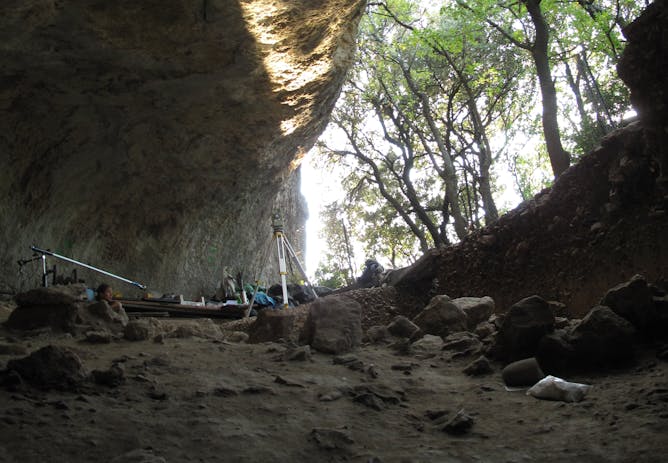|
|
|
|
The National Oceanic and Atmospheric Administration yesterday released a report warning that the pace of sea level rise is accelerating and that the U.S. can expect another 10 to 12 inches of water on average by 2050. Geoscientist Jianjun Yin from the University of Arizona breaks down the different ways global warming is causing rising seas, and he notes that the effects will not be uniform: “The U.S. East Coast and Gulf Coast, for example, face risks above the average, according to the new report, while the West Coast and Hawaii are projected to be lower than average.”
Another major science story over the past week was a discovery that could rewrite the history of when modern humans – Homo sapiens – made their way to Europe. A team of researchers describes an archaeological dig in a cave in France that Neanderthals inhabited before and after Homo sapiens. Among the findings the group made is evidence of a modern human presence in Europe 54,000 years ago, some 10,000 years earlier than previously believed.
One of the promises of gene therapy, which involves altering the genes in a patient’s cells, is to treat very rare genetic diseases. Miguel Sena-Esteves, a neuroscientist from UMass Chan Medical School, reports on the success his research team has had in treating Tay-Sachs disease in two children using gene therapy, part of a 14-year research project. Although the clinical results are promising, he notes the cost of such treatments for ultrarare diseases remains a barrier to broader use.
Also in this week’s science and research news:
If there’s a topic you’d like our team of science editors to investigate, please reply to this email.
|

|
Martin La Monica
Director of Editorial Projects and Newsletters
|
|

Tidal flooding is creeping farther into coastal towns like Alexandria, Virginia.
Matt McClain/The Washington Post via Getty Images
Jianjun Yin, University of Arizona
A sea level scientist explains the two main ways climate change is threatening the coasts.
|

The Grotte Mandrin rock shelter saw repeated use by Neanderthals and modern humans over millennia.
Ludovic Slimak
Ludovic Slimak, Université Toulouse – Jean Jaurès; Clément Zanolli, Université de Bordeaux; Jason E. Lewis, Stony Brook University (The State University of New York); Laure Metz, University of Connecticut
Stone artifacts and a fossil tooth point to Homo sapiens living at Grotte Mandrin 54,000 years ago, at a time when Neanderthals were still living in Europe.
|

About 1 in 300 people in the general population carry the Tay-Sachs disease gene.
Ray Kachatorian/Stone via Getty Images
Miguel Sena-Esteves, UMass Chan Medical School
Tay-Sachs is a rare and fatal neurodegerative disorder that most commonly affects children. Researchers have developed the first Tay-Sachs treatment to reach clinical trials.
|
|
|
-
Scott Creel, Montana State University
African wild dogs are used to evading hyenas and lions. Genetic research suggests they are using the same strengths to get around human development as well.
-
Elissa H. Patterson, University of Michigan; Hans Schroder, University of Michigan
Drug manufacturers often shun the use of placebos in clinical trials. But research suggests that placebos could play an important role in the treatment of depression, pain and other maladies.
-
Stephen Soumerai, Harvard University; Ross Koppel, University at Buffalo
A well-intentioned public health message has had serious negative impacts on the treatment of young people for depression.
-
Eric Smalley, The Conversation
Whether the cryptocurrency hype makes you crypto curious or crypto skeptical, there are many ways your life could be affected by crypto’s underlying technology, blockchain.
-
Mojtaba Sadegh, Boise State University; John Abatzoglou, University of California, Merced; Mohammad Reza Alizadeh, McGill University
The risk from heat waves is about more than intensity – being able to cool off is essential, and that’s hard to find in many low-income areas of the world.
-
Dario Ghersi, University of Nebraska Omaha
COVID-19 has taken away so much. An immunology researcher describes the good it may leave behind.
-
James Dillard, Penn State
Whether about a comet hitting the Earth or a virus infecting the world, fear-based messages often do not succeed at changing people’s behaviors.
-
Gabriel Filippelli, IUPUI
The Biden administration is moving to revive mercury limits for coal-fired power plants. A scientist explains mercury’s health risks and the role power plants play.
|
|
|
Like this newsletter? You might be interested in our other weekly emails: Enjoy reading
The Conversation? Share us with your three closest friends:
|
| |
| |
| |
| |

|
| |
| |
| |
| |
| |
| |
|
|
|
|
|
|
|